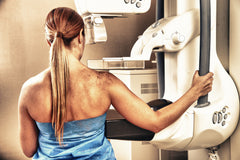
A mammogram is an X-ray of the breast that is used to find cancer. Its popularity grew in the 1970s as doctors started to realize they needed something better than just a breast exam to detect a lump. So … radiation to the rescue!
Today, conventional medicine supports regular mammograms as the best approach for early breast cancer detection. But this universal support is definitely starting to wane.
The opposition is mostly coming from natural medicine practitioners. They believe that there are two things that should make us question mammography as a screening tool:
- The high dose of harmful radiation used during the exam.
- The high rate of false positives, which means to diagnose cancer when no cancer exists.
Let's take a look at each one of these and then talk about a safer option worth considering.
Mammograms Use Dangerous Ionized Radiation
Scientists agree that there is no safe dose of radiation. Cellular DNA in the breast is more easily damaged by very small doses of radiation than thyroid tissue or bone marrow; in fact, breast cells are second only to fetal tissues in sensitivity to radiation.
And the younger the breast cell, the more easily its DNA is damaged by radiation. The National Cancer Institute agrees with this fact.1 The distinguished institute states that mammography is dangerous for younger women.
In fact, they report that …"mammograms expose the breast to radiation. The risk of harm from this radiation exposure is slight, but repeated x-rays have the potential to cause cancer."
The respected organization goes on to say, "The benefits, however, nearly always outweigh the risk. Women should talk with their health care providers about the need for each X-ray."1
Finally, mammography breaks the Hippocratic Oath. Since the inception of mammography, the incidence of pre-cancerous lesions, called DCIS, has increased.2 Researchers in Spain followed women receiving mammograms between 1983 and 2007. They reported that a sharp rise in pre-cancerous lesions occurred until 1997, followed by a less marked upward trend.
The authors concluded, "Among women aged 50–69 the increase was particularly important between 1992 and in 1996, reflecting the spread in mammography use." So a test supposedly used to detect cancer can actually cause it. Well, so much for that "do no harm" thing.
Please note: to be fair, some experts believe that mammography has not caused an increase in breast lesions, but instead is simply finding more.
False-Positive Results are a Problem with Mammograms
Many doctors have trouble trusting mammograms due to their enormously high rate of false positives. This is when a doctor makes the diagnosis of cancer but no cancer exists. In one large study looking at 137,949 women, the researchers found that the more frequently mammograms are done, the greater the risk of false-positives.3This is amazing when you consider that mammography is the main screening tool used to detect breast cancer. Yet, the more we use it, the less successful it is in screening for cancer. One of the reasons for false-positive results might be linked to doctor inexperience. So, if you’re going to have a mammogram, make sure an experienced radiologist will be looking at your results.4
These false-positive results create a great amount of emotional stress on patients and family members involved. The emotional stress of believing you have cancer when you do not is enough to trigger the onset or the acceleration of a disease in the body.
Even worse, these erroneous results lead to many unnecessary and invasive biopsies. Many women have undergone unnecessary chemotherapy, radiation and mastectomies after receiving false-positive results on a mammogram.
An MRI is a Safe & Effective Alternative to a Mammogram
An MRI is a procedure that uses a magnet, radio waves and a computer to make a series of detailed pictures of areas inside the body. This procedure is also called nuclear magnetic resonance imaging (NMRI). An MRI does not use any X-rays.
In women with a high inherited risk of breast cancer, screening trials of MRI breast scans have shown that an MRI is more sensitive than mammography for finding breast tumors.
It is uncommon for MRI breast scan results to appear abnormal even though no cancer is present. Screening studies of breast MRI in women at high inherited risk are ongoing.
An MRI may be used to:
- Detect cancer in normal risk women.
- Study lumps in the breasts that remain after traditional breast cancer treatments.
- Plan surgery for patients with known breast cancer.
The only down-side to MRI is the cost. Not all insurance companies will pay for it as a screening tool. In that case, you might consider digital mammography. This involves less radiation than traditional mammography.
Here's what we suggest: Talk to your doctor about your overall risk for breast cancer. If it's low to moderate, then consider an MRI for routine screening. If it's a high risk, you may need a combination of screening tests and genetic testing.
References
- http://www.cancer.gov/cancertopics/screening/breast/understanding-mammograms/UnderstandingMammogramsandYourRiskforBreastCancer.pdf
- Breast. 2012 Feb 14. [Epub ahead of print]
- Cancer Epidemiol Biomarkers Prev. 2012 Feb 15. [Epub ahead of print]
- Eur Radiol. 2011 Oct;21(10):2083-90.
